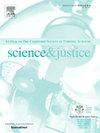Evaluation of silver mirror chemical delamination on dusted fingermarks
IF 1.9
4区 医学
Q2 MEDICINE, LEGAL
引用次数: 0
Abstract
Airborne substances are common contaminants and often interfere on fingermarks compositions and their development procedures. This study analyzed the efficiency of silver mirror delamination technique to develop fingerprints deposited on mirrors submitted to an airflow. The silver mirror delamination consists of subjecting the mirror into a chemical treatment in order to obtain a transparent substrate and improve the conditions for recording fingerprints with simple photography equipment. The fingerprint images were evaluated with LCMetric software and ACE-V methodology. The results showed that fingerprints suffered severe degradation by dust deposition and mirror delamination assessment was unable to recover the vast majority of fingerprints. However, there were fingermarks that achieved “good” quality score in LCMetric software evaluation and were considered with comparison value by human evaluation (ACE-V), making the mirror delamination procedure suitable as a prior and contactless technique among the attempts to recover the contaminated fingermarks.
银镜化学分层对沾尘手印的评价
空气传播的物质是常见的污染物,经常干扰手印成分及其形成过程。本研究分析了银镜分层技术在气流作用下在银镜上沉积指纹的效率。银镜分层是通过对银镜进行化学处理,以获得透明的基片,改善用简单的摄影设备记录指纹的条件。采用LCMetric软件和ACE-V方法对指纹图像进行评价。结果表明,指纹受到粉尘沉积的严重退化,镜像分层评估无法恢复绝大部分指纹。然而,有一些手印在LCMetric软件评估中获得了“良好”的质量分数,并被认为具有人工评估(ACE-V)的比较值,这使得镜像分层程序适合作为恢复污染手印的首选和非接触式技术。
本文章由计算机程序翻译,如有差异,请以英文原文为准。
求助全文
约1分钟内获得全文
求助全文
来源期刊

Science & Justice
医学-病理学
CiteScore
4.20
自引率
15.80%
发文量
98
审稿时长
81 days
期刊介绍:
Science & Justice provides a forum to promote communication and publication of original articles, reviews and correspondence on subjects that spark debates within the Forensic Science Community and the criminal justice sector. The journal provides a medium whereby all aspects of applying science to legal proceedings can be debated and progressed. Science & Justice is published six times a year, and will be of interest primarily to practising forensic scientists and their colleagues in related fields. It is chiefly concerned with the publication of formal scientific papers, in keeping with its international learned status, but will not accept any article describing experimentation on animals which does not meet strict ethical standards.
Promote communication and informed debate within the Forensic Science Community and the criminal justice sector.
To promote the publication of learned and original research findings from all areas of the forensic sciences and by so doing to advance the profession.
To promote the publication of case based material by way of case reviews.
To promote the publication of conference proceedings which are of interest to the forensic science community.
To provide a medium whereby all aspects of applying science to legal proceedings can be debated and progressed.
To appeal to all those with an interest in the forensic sciences.
 求助内容:
求助内容: 应助结果提醒方式:
应助结果提醒方式:


